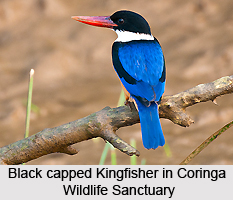 The Coringa Wild Life Sanctuary is located in the East Godavari district of Andhra Pradesh. The sanctuary is easily accessible as it is located about 20 kms from Kakinada and 70 kms from Rajahmundy. The region covers an area of 235 square kilometers. In July 1978 the park was declared as a sanctuary. Coringa Sanctuary is located near Kakinada port along the Bay of Bengal.
The Coringa Wild Life Sanctuary is located in the East Godavari district of Andhra Pradesh. The sanctuary is easily accessible as it is located about 20 kms from Kakinada and 70 kms from Rajahmundy. The region covers an area of 235 square kilometers. In July 1978 the park was declared as a sanctuary. Coringa Sanctuary is located near Kakinada port along the Bay of Bengal.
The Coringa Wild Life sanctuary is formed in the delta and estuary region of the River Godavari. The sanctuary was formed to conserve the natural mangrove vegetation that grows in the region. It is renowned for reptiles and the most famous ones are the salt-water crocodiles. The sanctuary is thus rich in flora and fauna
Flora and Fauna of Coringa Wild Life Sanctuary
Coringa Wild Life Sanctuary houses a wide variety of flora and fauna. Coringa wildlife sanctuary is part of the Godavari mangroves. Thirty five mangrove plant species belonging to 24 families are present in the sanctuary. Mangroves are extremely tolerant to saline water and grow in the tropical and sub tropical estuary regions. In this sanctuary the mangrove plants display curious adaptations such as stilt roots as in Rhizophora. Avicennia officinalis, Avicennia marina, Avicennia alba, Excoecaria agallocha, Rhizopora mucronata, Ceriops decandra, Bruguiera gymnorrhiza, Lumnitzera racemosa, Sonneratia apetala, Rhizophora conjugata, Aegiceras corniculatum, Thespesia populneoides, Hibiscus tiliaceous are some of the mangroves growing here.
The sanctuary also has a heavy growth of shrubs and herbs that include Dalbagia spinosa, Derris trifoliate, Acanthus ilicifolius, Clerodendrum inerme, Suaeda maritima, Suaeda monoica, Porteresia coarctata, Myriostachya wightiana. A unique feature of the sanctuary is the nesting of the Olive Ridley-Sea Turtle in the months of January to March in the 18 kilometer long sand path in the sanctuary.
Coringa Wild Life Sanctuary also houses a wide variety of animal population like the avian fauna, mammals and insects. The soil surface of mangroves provides shelter to Mudskippers, Crabs and Molluscs while the waters give refuge to Smooth Indian Otters, Fishing Cat, crocodiles, sea turtles and others. Apart from these the sanctuary also has a collection of 125 species of birds that include the Crested Serpant Eagle, Scarlet Minivet, Indian Roller, Black capped Kingfisher, Oriental Dwarf Kingfisher, White bellied Woodpecker, Snipes, Ducks, Sea Gulls and Flamingos.
The best season to visit the Coringa Wild Life Sanctuary is during the months of October to May. The temperature of the sanctuary is relatively high and humid. Thus a visit to the Coringa Wild Life Sanctuary provides the tourists an insight about the rich flora and fauna of the state of Andhra Pradesh.



















